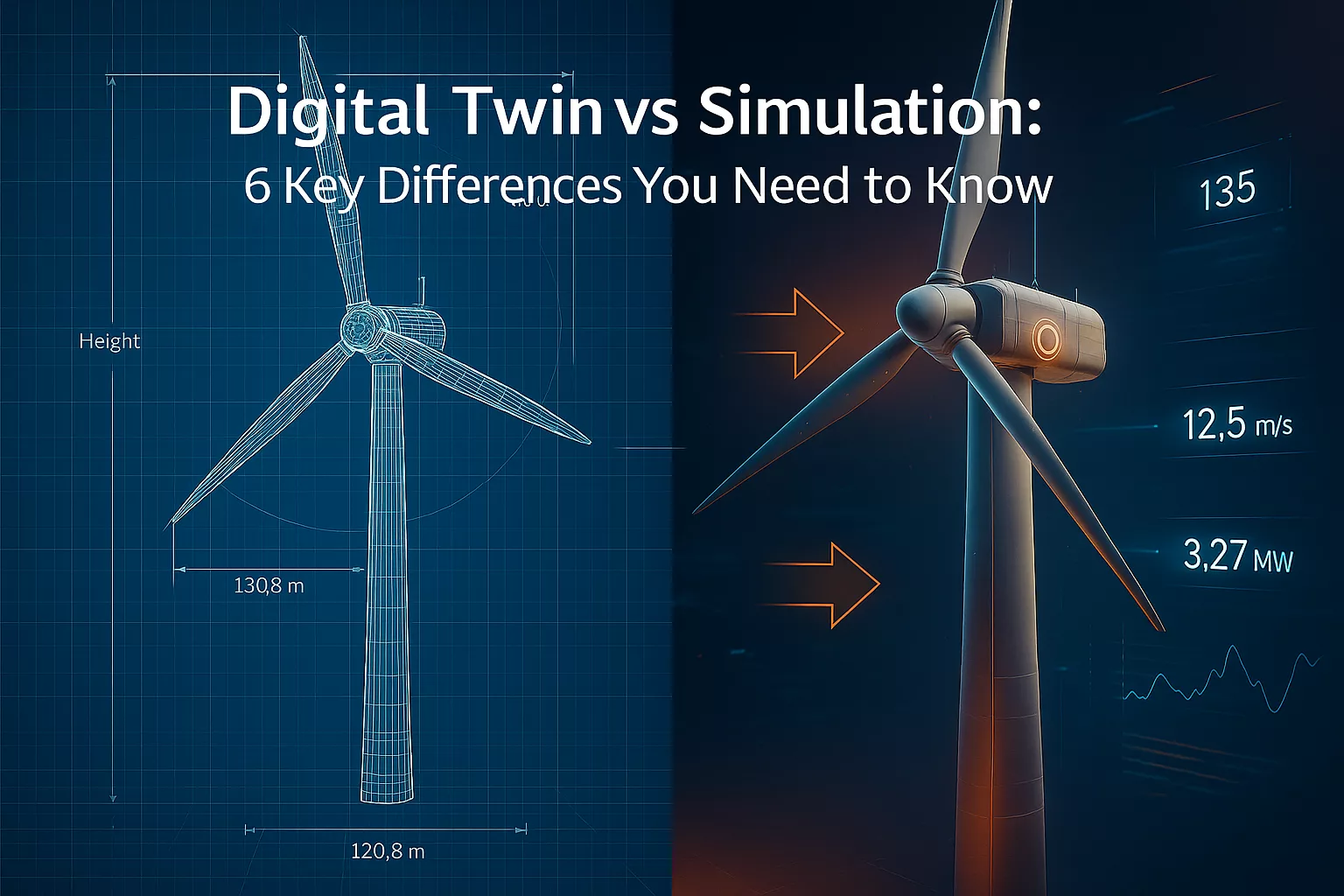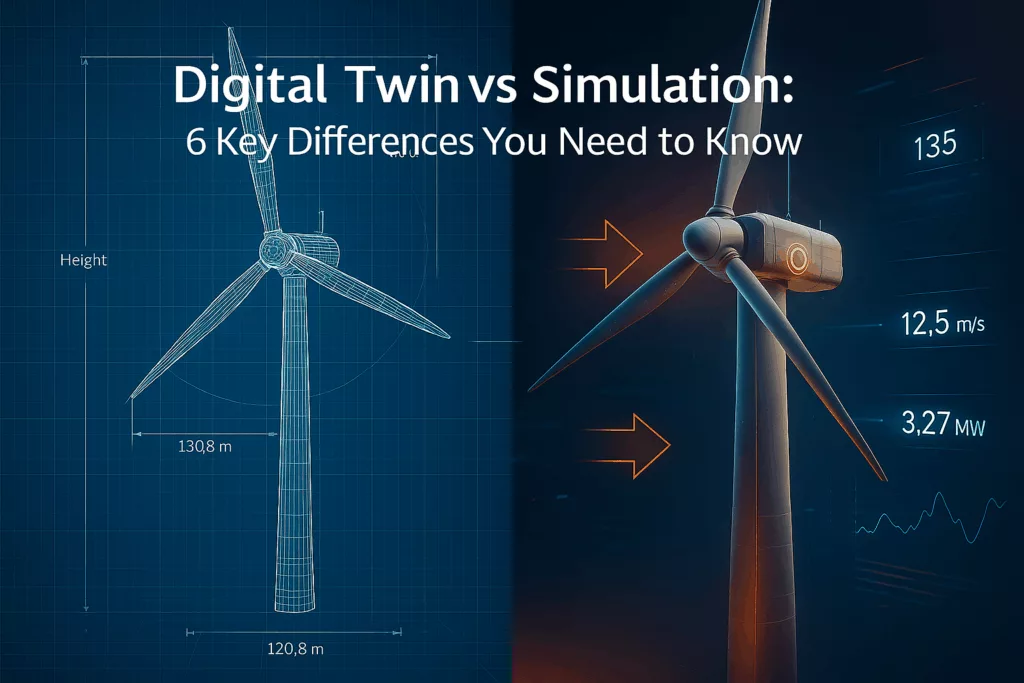
Introduction
The digital twin vs simulation debate is a common point of confusion for leaders in technology and engineering. While both terms describe powerful virtual models used to analyze complex processes, they are fundamentally different tools with unique purposes. Confusing them is like mistaking a static blueprint for a live security feed—one predicts what could happen, while the other shows what is happening.
Understanding this distinction is crucial for any business leader looking to leverage technology for a competitive edge. In this article, we’ll settle the digital twin vs simulation question by breaking down the six fundamental differences to help you choose the right tool for your needs.
Table of Contents
Key Takeaways
- The Core Difference: A digital twin is a dynamic, virtual model of a specific, physical object that is updated with real-time data. A simulation is a virtual model that explores “what-if” scenarios and is not connected to a real-world object in real-time.
- Data Flow: The key differentiator is the data link. A digital twin has a two-way data flow, allowing it to receive data from its physical counterpart and send insights back. A simulation’s data is manually input and flows one way.
- Purpose: Use a simulation to analyze how a system might behave under certain conditions (e.g., designing a new product). Use a digital twin to monitor, diagnose, and optimize how a real system is behaving right now.
What is a Simulation? A Tool for “What-If” Scenarios
On one side of the digital twin vs simulation discussion, you have the simulation: a computer-based model that imitates the behavior of a real-world system or process. Engineers use simulations to test hypotheses in a controlled, digital environment. They can ask questions like, “What would happen to this wind turbine blade if it faced hurricane-force winds?” or “How would traffic flow if we added a new lane to this highway?”
The key here is that a simulation operates on assumptions and data that are manually input. It runs for a specific duration to explore a particular scenario and then it stops. It is an invaluable tool, but it is not connected to a living, breathing physical object.
What is a Digital Twin? A Living Model for “What-Is” Analysis
On the other side of the digital twin vs simulation equation, you have the digital twin. It is far more than a static model; it is a dynamic, virtual representation of a specific physical asset or process that exists in the real world. This virtual twin is constantly updated with real-time data from IoT sensors attached to its physical counterpart.
This live data connection is the magic ingredient. A digital twin of a wind turbine doesn’t just theorize about performance; it shows you exactly how that specific turbine is performing at this very moment. It tracks its energy output, the stress on its gears, and the temperature of its components, evolving and changing just as the real turbine does.(For a deeper dive, read our foundational article, “What is Digital Twin Technology – How, Why, and When to Use It?)
The concept originated with NASA, who needed to create virtual models of their spacecraft that were deeply integrated with the real vehicle to monitor and simulate problems while they were still in space. NASA Apollo program.
The 6 Core Differences at a Glance
To truly understand the gap between these two technologies, let’s break down their key differences.
1. Data Source & Flow
- Simulation: Uses static data that is manually loaded for a specific test. The data flow is one-way: from the user into the model.
- Digital Twin: Uses a continuous stream of real-time data from IoT sensors. The data flow is two-way: the physical object sends data to the twin, and insights from the twin can be used to control or optimize the physical object.
2. Lifecycle Integration
- Simulation: Typically used at the beginning of a product’s life—during the design, analysis, and validation phases. It’s used to perfect a design before it’s built.
- Digital Twin: Is created once the physical asset is built and operates alongside it for its entire lifecycle, from commissioning to operation to decommissioning.
3. Primary Purpose
- Simulation: To analyze and predict how a type of object would perform under various hypothetical “what-if” scenarios.
- Digital Twin: To monitor and optimize the performance of a specific physical object in its actual “what-is” operating environment.
4. Scope
- Simulation: Often has a narrow scope, designed to answer a single question or analyze one specific subsystem.
- Digital Twin: Has a broad scope, often representing the entire asset or even a system of assets. It can be used to answer many different questions over time.
5. Connection to the Physical World
- Simulation: Has no link to a real-world object. It exists entirely in a virtual space.
- Digital Twin: Is inextricably linked to its physical counterpart. One cannot exist without the other.
6. State and Time
- Simulation: Is “stateless.” Each simulation run is a discrete event, a snapshot in time that doesn’t remember past results.
- Digital Twin: Is “stateful.” It maintains a history of its physical twin’s performance and condition, allowing it to learn and make increasingly accurate predictions over time.
Comparison Table: Digital Twin vs. Simulation
To truly visualize the digital twin vs simulation, a side-by-side comparison is the clearest way to see where each technology shines. This table breaks down their core attributes.
| Feature | Simulation | Digital Twin |
| Data Source | Static, manually input | Real-time, from IoT sensors |
| Data Flow | One-way | Two-way |
| Purpose | “What-if” analysis | “What-is” optimization |
| Lifecycle | Primarily Design Phase | Entire Operational Life |
| Connection | None to physical world | Directly linked to a physical asset |
| Scope | Often narrow, answers one question | Broad, provides a holistic view |
A Critical Consideration: Complexity and Investment
It’s important to note that the power and complexity of the technology is a key factor in the digital twin vs simulation decision. While a simulation can be run on a single computer, a digital twin requires a robust infrastructure of IoT sensors, data networks, cloud computing, and analytics platforms. The initial investment is higher, but as noted by industry analysts like Gartner, the returns from improved efficiency and predictive maintenance often justify the cost. [Emerging Technologies: Revenue Opportunity Projection of Digital Twins]
Conclusion: Choosing the Right Tool for the Job
Ultimately, the digital twin vs simulation question isn’t about choosing which is better overall, but which is the right tool for a specific task. A simulation is your architect’s blueprint—a powerful way to design and test ideas in a virtual sandbox. A digital twin is your 24/7 operations manager for the finished building—a living model that ensures peak performance.
Understanding this difference is the first step to unlocking the true potential of digital transformation for your business.
if you’re ready to explore how a digital twin can be applied to your business, contact our experts today.
FAQs
Can you use a simulation to create a digital twin?
Yes, absolutely. In fact, the detailed model created during the simulation phase of a product’s design is often the perfect starting point for its digital twin.
The crucial step that transforms it from a simulation into a digital twin is connecting it to the actual physical product with real-time data streams from IoT sensors once the product is built and in operation.
Is a digital twin always a 3D model?
Not necessarily. While many digital twins use sophisticated 3D visualizations because they are intuitive, the core of a digital twin is the underlying data model and its real-time connection.
A digital twin can be a complex dashboard of graphs, data streams, and performance indicators without any 3D representation at all. The visualization is a user interface; the data integration is the core technology.
In the digital twin vs simulation comparison, which is better for a small business?
It depends entirely on your business goals. If you are in the process of designing a new product, a simulation is essential and more cost-effective for testing ideas.
If your business relies on managing expensive physical equipment and you want to reduce downtime and optimize operations, investing in a digital twin for your most critical assets could provide a massive return on investment.
Does a digital twin have to be of a single object?
No. While we often talk about a twin of a single object (like an engine or a pump), you can also create a digital twin of an entire process or system. For example, a company could have a digital twin of its entire assembly line, which is composed of many individual machines. This allows them to optimize the workflow and interactions between assets, not just a single part.
you can look at this exmaple



Helpful, much appreciated.
Thanks.